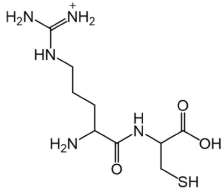
Name and point out 4 functional groups that are found in this molecule.
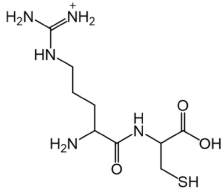
Amino (-NH2), Carbonyl:Ketone (C=O middle of moelcule), Carboxyl (-COOH), Sulfhydryl (-SH)
What are the roles of the following, and are they part of cellular respiration, photosynthesis, or both?
A) Z-protein
B) ATP synthase
C) NADH and FADH2
D) Cytochrome b6-f complex
A) Z-protein splits water to provide electrons to the E.T.C.; photosynthesis
B) ATP synthase uses the force of H+ flowing from high concentration to low concentration to phosphorylate ADP, producing ATP; both
C) NADH and FADH2 are electron carriers that have oxidized derivatives of glucose and bring the electrons and hydrogen ions to the E.T.C. to build an electrochemical gradient; cellular respiration
D) Cytochrome b6-f complex is a proton pump in the thylakoid membrane that uses energy from electrons to pump H+ into the lumen, creating an electrochemical gradient; photosynthesis
What is the central dogma of modern biology? Be specific and identify key players in each stage.
DNA gets transcribed by RNA polymerase to form mRNA in the nucleus. mRNA leaves the nucleus and goes to a ribosome and is translated into a protein by linking amino acids brought by tRNA.
Provide an example of a negative feedback loop. Be sure to include how the system returns to homeostasis from both extremes.
Answers vary.
Blood-glucose levels:
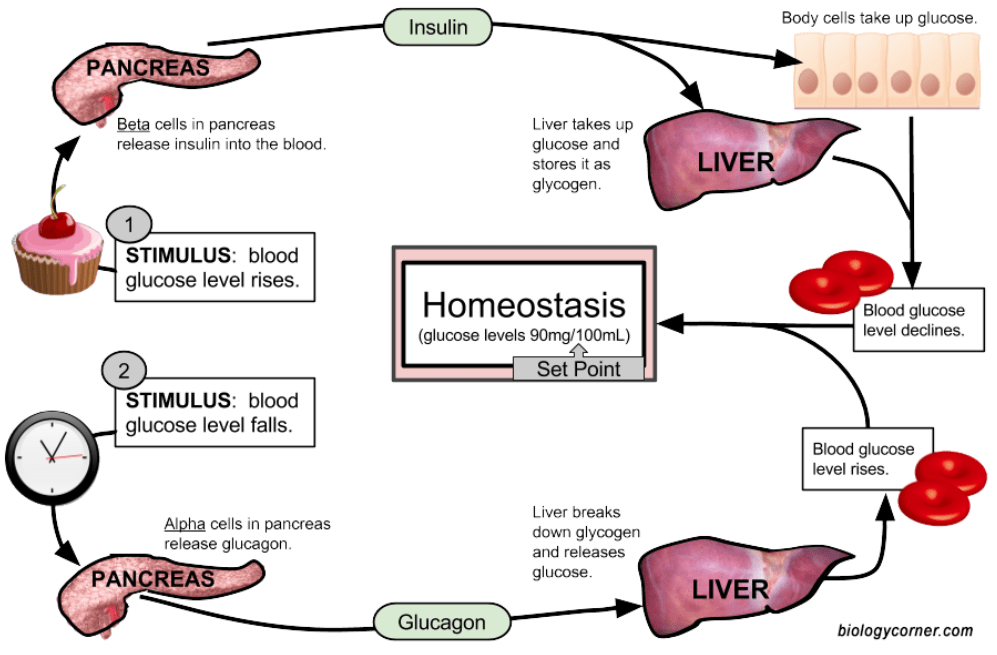
Thermoregulation:
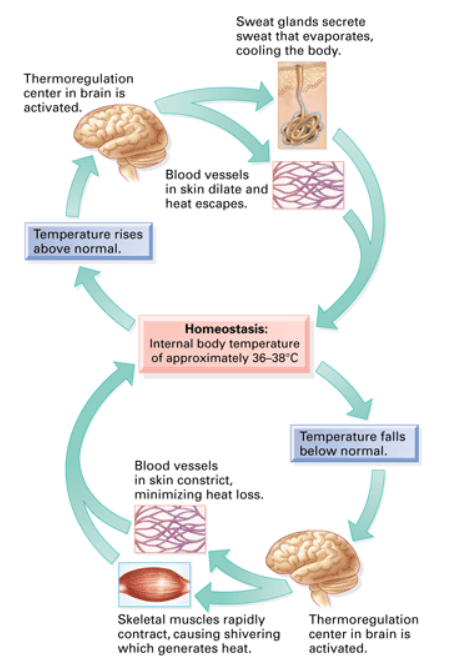
Describe the differences between crude and ecological density.
Crude density estimates the number of individuals in a population in the total sample area. (ex: number of turtles in a nature park)
Ecological density estimates the number of individuals in a population in the portion of the sample area that is actively inhabited by the organisms. (ex: number of turtles in lakes in a nature park)
Describe what is happening to this cell, using proper vocabulary to identify the extracellular solution, and what you would do to return it to an isotonic state.
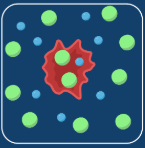
The cell has crenated (shrivelled) due to being in a hypertonic solution. The osmotic balance has been disrupted, because there are a greater number of solutes outside the cell (and fewer water molecules). Water flows out of the cell and into the extracellular solution to reach equilibrium.
To make the solution isotonic (equal amounts of solutes inside and outside the cell), a hypotonic solution should be added (more water than solute). This would dilute the extracellular fluid and cause water to flow back into the cell.
Compare and contrast the mitochondria and the chloroplast.
What are some similarties in their structures and processes?
What are some differences in their structures and processes?
Both are double-membrane organelles that use electron carriers to power E.T.C. Both take advantage of concentration gradients to produce ATP.
Mitochondria perform aerobic cellular respiration, and use the oxidation of glucose for E.T.C. and chemiosmosis to produce ATP. Oxygen is required as a final electron acceptor, forming water.
Chloroplasts perform photosynthesis, and harness light energy and carbon dioxide to build sugars in light dependent reactions and light independent reactions, respectively. Water is split to provide electrons for the E.T.C., creating oxygen.
Describe the following mutations using concrete examples.
A) Nonsense mutation
B) Frameshift mutation
C) Silent mutation
D) Missense mutation
A) Substitution of a nucleotide that changes the location of stop codons, leading to premature or late termination of a sequence. Created protein is non-functional.
B) Insertion or deletion of nucleotides in singles or pairs that shifts the entire genetic code, drastically altering codons and leading to a non-functional protein.
C) Substitution of a nucleotide that alters the codon but does not change the identify of the amino acid that is coded for, due to the redundancy of the genetic code. Created protein remains functional.
D) Substitution of a nucleotide that alters the codon and ends up changing the identity of the amino acid that is coded for. Because of different side-chain interactions, produced protein may be non-functional.
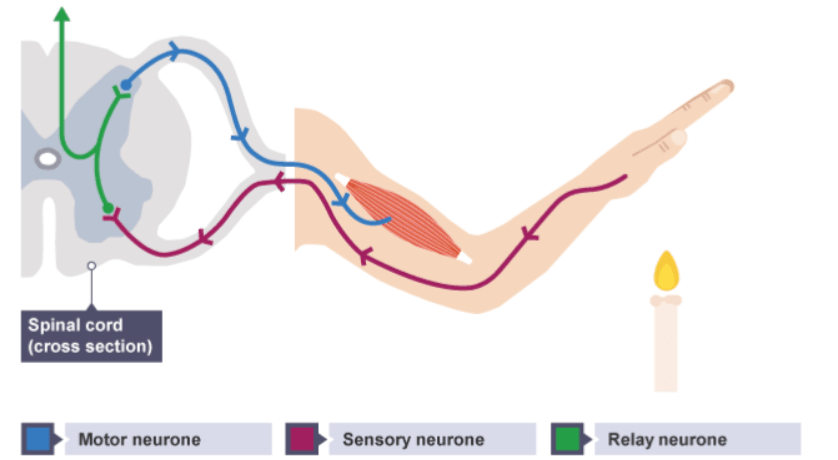
Compare and contrast the fucundity and reproductive strategies of Type III (r) and Type I (k) survivorship. Provide specific examples of each, and describe the type of growth that would be expected for each population.
What are the benefits and drawback of each strategy?
Type I (k): Ex-Humans, elephants. Likely to exhibit geometric growth during breeding season, or logistic growth with a carrying capacity (lag phase, geometric/exponential, slowing and stabilizing in a dynamic equilibrium around carrying capacity). Low fecundity with parental care, longer lifespans.
Type III (r): Ex-Bacteria, oysters, insects. Likely to exhibit exponential growth with population crash. High fecundity and large number of offspring, with short lifespan and high mortality rates.
Glycerol and and 3 fatty acids are joined to form a triglyceride.
A) What type of reaction is this?
B) What type of bond is formed?
C) What is one other product that is made from this reaction?
A) Condensation / dehydration synthesis
B) Ester bond (found in lipids)
C) Water (3 molecules, one for each fatty acid)
What are the roles of the following electron carriers? Be specific, and identify stages in cellular respiration or photosynthesis where they occur. Identify their oxidized and reduced forms.
A) NAD+
B) NADP+
C) FAD
A) NAD+ is the oxidized form and NADH is the reduced from in cellular respiration. NAD+ is involved in glycolysis, pyruvate oxidation, and Kreb's Cycle. NADH provides electrons and hydrogen to three proton pumps in the E.T.C.
B) NADP+ is the oxidized form and NADPH is the reduced form in photosynthesis. NADPH is formed by non-cyclic phosphorylation in PSI by NADP+ reductase. NADPH provides electrons and hydrogen to reduce BPG into G3P, the precursor to glucose.
C) FAD is the oxidized form and FADH2 is the reduced form in cellular respiration. FAD is involved in the Kreb's Cycle, and is also formed when NADH made by glycolysis crosses into the mitochondrion. FADH2 supplies electrons and hydrogen to two protons pumps in the E.T.C.
What would be the result if the following enzymes were denatured? Be clear about which process would be disrupted.
A) RNA polymerase
B) Helicase
C) Spliceosomes
D) The repressor protein in the lac operon
A) mRNA could not be produced during DNA transcription, so no protein could be made
B) DNA would be unable to unwind/unzip, and would be unable to replicate before cell division
C) mRNA could not be modified to remove non-coding introns and join coding exons. Incorrect amino acid sequence would lead to a non-functional protein.
D) Production of lactose could not be controlled in the operator region, and energy would be wasted producing lactase at all times.
Describe three specific ways that the endocrine system, urinary system, and/or nervous system are linked.
Answers vary.
(Endocrine and urinary): Hormonal control of water retention in the nephron by aldosterone and antidiuretic hormone.
(Nervous sytem and endocrine): Short and long-term stress responses by the hypothalamus/pituitary gland and adrenal glands. (Ex: Hypothalamus triggers pituitary glad to release ACTH, which triggers adrenal cortex to release cortisol in long-term stress response)
(Nervous system and urinary): Sensory neurons in the bladder send signals to the spinal cord/brain when there is a certain level of expansion, and effector neurons return to signal the spincter to release urine.
What are some 5 factors that limit population growth rates? Identify whether these factors are density dependent or density independent.
Answers vary.
Disease (DD)
Food/water (DD)
Forest fire (DI)
Competition (DD)
Climate change (DI)

Use terminology from this course to identify the types of transport that are being shown. Be clear about what each number represents.
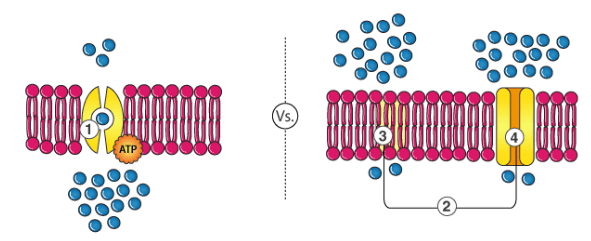
1. Active transport: ATP is required to move solutes across a membrane against their concentration gradient (low to high)
2. Passive Transport: transport across a membrane without the use of energy.
3. Diffusion: passive movement of small, uncharged substances across a membrane from high to low concentration
4. Facilicated diffusion: passive movement of larger or charged substances across a membrane from high to low concentration with help from a channel/carrier protein
Briefly describe the purpose of the following stages using some of the terms below, and any other vocabulary words from this course.
aerobic/anaerobic, catabolic/anabolic, exergonic/endergonic, oxidative phosphorylation/subtrate-level phosphorylation, oxidize/reduce
A) Chemiosmosis
B) Calvin Cycle
D) Glycolysis
E) Kreb's Cycle
A) Chemiosmosis: ATP synthase uses an electrochemical gradient of H+ and oxidative phosphorylation to create ATP.
B) Calvin Cycle: Rubisco joins carbon dioxide and RuBP in carbon fixation to start a cycle that reduces the carbon dioxide into G3P (a precursor to glucose). This is a anabolic/endergonic reaction.
C) Glycolysis: An anaerobic set of reactions that oxidize glucose in the cytoplasm of a cell, and uses subtrate-level phosphorylation to generate net 2 ATP. This is a catabolic/exergonic set of reactions.
D) Kreb's Cycle: An indirectly aerobic set of reactions that further oxidize glucose derivatives by joining acetyl to oxaloacetate in a cycle. This is a catabolic/exergonic set of reactions.
Briefly describe a genetic technology that has benefitted humans and how it is used.
Answers vary. Some options:
DNA transformation: Inserting a gene into a bacteria plasmid (potentially using a viral vector and restriction enzymes) in order to mass-produce biological molecules such as insulin for diabetics.
PCR: Amplifying a DNA sequence by mimicking the DNA replication process in the lab (using Taq polymerase and primers) has allowed for genes to be isolated, detection of coronovirus antigens from nose swabs, and forensic analysis of DNA left at a crime scene.
Gel electrophoresis: Separation of base pair sequences based on fragment length (size) using a charged agarose gel has been used to isolate genes and compare banding patterns to determine relatedness between species and families.
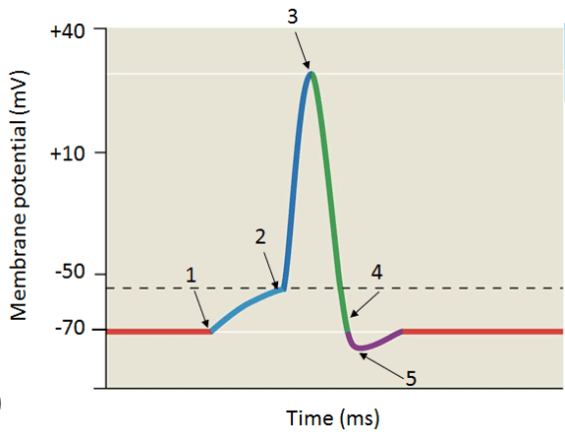
Identify what is occuring in the neuron using the numbers below for each stage of action potential. Be sure to discuss the locations and concentrations of relevant ions, and the effects of channels and pumps on membrane potential.
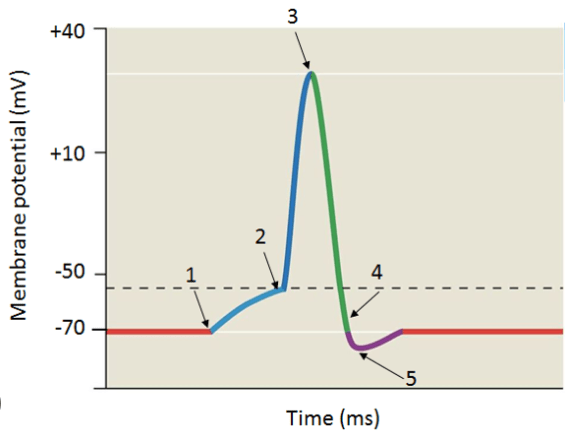
1. Resting potential of neuron (-70 mV) maintained by the sodium-potassium pump. Inside of axon is more negative, and contains negatively-charged proteins and high concentration of K+. Outside of axon is more positive, and contains a high concentration of Na+.
2. Threshold (-50 mV) reached, and action potential is initiated. All-or-nothing principle: must reach threshhold, or no action potential.
3. Depolarization (always to +30mV regardless of "strength" of signal) as sodium channels open and Na+ flood into the axon. Sodium channels close as action potential flows down axon.
4. Repolarization as potassium channels open and K+ flow out of the axon to re-establish internal negative charge.
5. Hyperpolarization as sodium-potassium pump moves 2 K+ in and 3 Na+ out using ATP, initially overcompensating before reaching resting membrane potential again.
Population Pyramids A, B, and C:
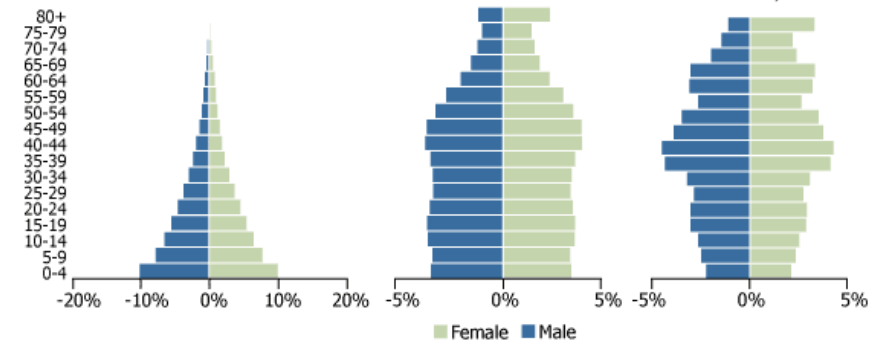
A) Which population pyramid has the highest growth rate? Explain factors that contribute to this.
B) Which stage of the DMT is population pyramid B? What do you predict it will look like in 100 years?
C) Do males or females have higher mortality rates in population pyramid C? What are some reasons for this?
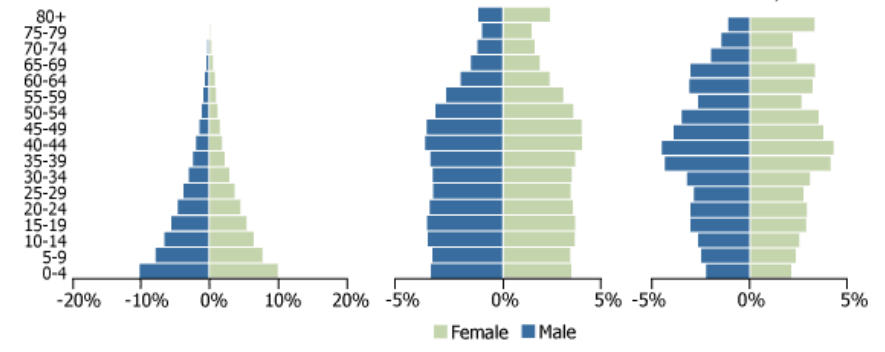
A) Pyramid A has the highest growth rate, because the base of the pyramid is widest, meaning a high potential for reproduction. Factors include high mortality in country, fewer resources for contraception and health care.
B) Stage 3: Stationary. Births = deaths so no sigificant population growth. Likely to reach stage 4, which is dynamic equilibrium around the carrying capacity.
C) Males have higher mortality rates. Higher statistical chances of certain diseases (ex. heart disease), difference in proactive care, more dangerous jobs or risky endeavors)
Explain why proteins are one of the most versatile macromolecules in the human body, that help our suvival. Provide at least 3 specific examples that relate to topics covered in this course. Go into as much detail as possible and try to link material from other units!
- Proteins can be structural. Hair and nails are made of kertin, and skin and muscle contain collagen. There are a variety of forms: primary (polypeptide), secondary (alpha and beta pleated sheets), tertiary (3-D), and quarternary (multiple subunits).
- Proteins can assist in transport across membranes (facilitated diffusion). The resting state of a neuron is maintained by the sodium-potassium pump, which uses ATP to pump 2 potassium ions into the axon and 3 sodium ions into the extracellular fluid.
- Proteins can act as enzymes to catalyze chemical reactions like in glycolysis. Phosphofructokinase catalyzes the phosphorylation of fructose-6-phosphate to fructose-1,6-biphosphate, and is allosterically inhibited by citrate/ATP and activated by ADP.
Compare and contrast the E.T.C.'s involved in photosynthesis and cellular respiration.
A) The purpose of each
B) The source of the energy used to run the proton pumps
C) The direction of the flow of protons (specific locations)
D) Any relevant molecules/enzymes involved
Cellular respiration's E.T.C. is used to create an electrochemical gradient of H+, in order to power ATP synthase to produce ATP. Electron carriers (NADH and FADH2) supply the electrons that run the 3 pumps. Oxygen is the most electronegative, final electron acceptor that drives the flow of electrons. H+ are pumped from the matrix into the intermembrane space (a concentrated place).
Photosystem II's E.T.C. is also used to create an electrochemical gradient of H+, in order to power ATP synthase to produce ATP, and Photosystem I's E.T.C. is used to produce NADPH. Excited electrons energized by photons in the reaction centre travel down the E.T.C., powering cytochrome b6-f complex to pump H+ from the stroma into the thylakoid lumen. Z-protein splits water to supply electrons lost by P680.
Why is a universal genetic code vital for understanding evolution, protein synthesis, genetic technologies, etc.? Draw on specific examples used in class, and emphasize the importance of nucleic acids as an instruction molecule for life.
Answers vary. Points to consider:
- The ability to connect relatedness between all life forms using 5 different base pairs: A, T, C, G, U
- The versatility to code for many different proteins, which catalyze reactions that build and break down other vital macromolecules for structures and energy
- The ability to transfer genes between organisms to produce useful macromolecules and GMO's
- The redundancy of the genetic code to help reduce the effects of accummulated mutations
- The understanding of the role of telomeres on lifespan (though long telomere length does not directly correlate to long lifespan) and of telomerase in understanding cancer
A) Describe how neurons transmit action potentials across a synapse. Use appropriate vocabulary (synapse, neurotransmitters, calcium ions, vesicles, presynaptic neuron, postsynaptic neuron, dendrite, axon terminal, receptors)
B) Using a drug of your choice, describe how the drug interferes with the normal process.
B) Answers vary. Some drugs block receptors, other prevent the re-uptake or destruction of neutrotransmitters in the synapse. Some interfere with natural inhibitors.
A) What are some major milestones in human population growth that have allowed humans to grown exponentially?
B) What are the benefits and drawbacks?
C) Based on what you know about DMT and limiting factors, what can be expected for the future of humanity? (optimistic standpoints welcome)
A) Agriculture, diversification of roles leading to intellectualism and societal structures, medicine, industrialization, technological advances allowing for expansion into locations with extreme climates, etc.
B) Answers vary
C) If the majority of countries can be supported financially and through medicine/resources to Stage 4 of the DMT, the human population can slow its growth and reach a dynamic equilibrium around a (albeit high) carrying capacity, and avoid a dramatic population crash and conflicts around resource scarcity.